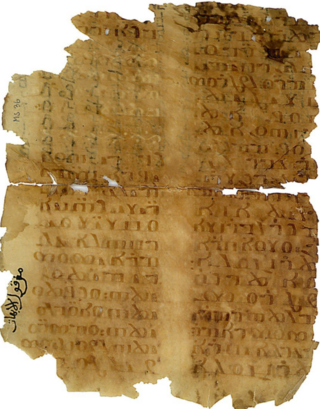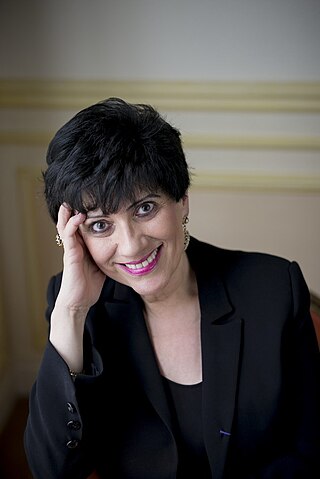Related Research Articles
Garshuni or Karshuni are Arabic writings using the Syriac alphabet. The word "Garshuni", derived from the word "grasha" which literally translates as "pulling", was used by George Kiraz to coin the term "garshunography", denoting the writing of one language in the script of another.
The Patrologia Orientalis is an attempt to create a comprehensive collection of the writings by eastern Church Fathers in Syriac, Armenian, Arabic, Coptic, Ge'ez, Georgian, and Slavonic, published with a Latin, English, Italian or mostly French translation. It is designed to complement the comprehensive, influential, and monumental Latin and Greek patrologies published in the 19th century. It began in 1897 as the Patrologia Syriaca, was discontinued in its original form and replaced by the Patrologia Orientalis. The collection began with those liturgical texts that touch on hagiography. Since then critical editions of the Bible, theological works, homilies and letters have been published.
Rolf Alfred Stein was a German-born French Sinologist and Tibetologist. He contributed in particular to the study of the Epic of King Gesar, on which he wrote two books, and the use of Chinese sources in Tibetan history. He was the first scholar to correctly identify the Minyag of Tibetan sources with the Xixia of Chinese sources.
Marcelle Lalou (1890–1967) was a 20th-century French Tibetologist. Her major contribution to Tibetology was the cataloging of the entire Pelliot collection of Old Tibetan manuscripts from Dunhuang at the Bibliothèque nationale de France. In addition to her cataloging work, she wrote articles on various aspects of Old Tibet, and she published a Tibetan textbook. Some of her most notable students include Rolf A. Stein and J. W. de Jong.

Christian Palestinian Aramaic (CPA) was a Western Aramaic dialect used by the Melkite Christian community in Palestine and Transjordan between the fifth and thirteenth centuries. It is preserved in inscriptions, manuscripts and amulets. All the medieval Western Aramaic dialects are defined by religious community. CPA is closely related to its counterparts, Jewish Palestinian Aramaic (JPA) and Samaritan Aramaic (SA). CPA shows a specific vocabulary that is often not paralleled in the adjacent Western Aramaic dialects.
François Nau was a French Catholic priest, mathematician, Syriacist, and specialist in oriental languages. He published a great number of eastern Christian texts and translations for the first and often only time.
Émile Poulat, was until 1954 a Catholic priest, associated with the Prêtres Ouvriers movement, and thereafter a French historian and sociologist. Director of Studies at the École des hautes études en sciences sociales, he was also director of research at CNRS and historian of the contemporary church. He was a founding member of the Group of Sociology of Religion, director and member of the editorial boards of several journals including Politica Hermetica. His research concentrated on the conflict between Catholic culture and modern culture in the history of contemporary Catholicism.
Jules Leroy was a French priest and researcher in the domains of Syriac, Coptic and Ethiopian manuscripts, art and architecture.
Geneviève Hasenohr is a French philologist and prolific scholar of medieval and Renaissance French literature. She has authored or contributed to more than forty books, written at least fifty academic articles and reviews, and prepared numerous scholarly editions.
Karima Dirèche is a French Algerian historian specialising in the contemporary history of the Maghreb. From September 2013 to August 2017, she has been the director of the Institute for Research on the Contemporary Maghreb in Tunis.

Joseph Yacoub is a historian and political scientist of Assyrian origin. His family moved from Salmas-Urmia, district in Iranian Azerbaijan and took refuge in Georgia during the First World War. From Tiflis/Tbilissi his family migrated to Syria which was during this time under French Mandate. His mother tongue is Aramaic and his first environment language is Arabic.His working language is mostly French.
Gérard Troupeau was a French scholar agrégé of Arabic, a professor at the Institut national des langues et civilisations orientales from 1961 to 1990, and director of studies of Arabic philology at the École pratique des hautes études.
Dominique Briquel is a French scholar, a specialist of archaeology and etruscology. Briquel studied at the École Normale Supérieure from 1964 to 1969 and was a member of the École française de Rome from 1971 to 1974. Since 1974 he taught Latin at the École Normale Supérieure. From 1984 to 1996 he was a professor of Latin at the University of Burgundy in Dijon. Since 1992, he has been Director of studies at the École pratique des hautes études, in the department of historical and philological sciences and since 1996, professor of Latin at the Université de Paris-Sorbonne.
Mireille Issa is a Lebanese medievalist born in Beirut. She studies the Late Latin period of Antiquity.

The Corpus Inscriptionum Semiticarum is a collection of ancient inscriptions in Semitic languages produced since the end of 2nd millennium BC until the rise of Islam. It was published in Latin. In a note recovered after his death, Ernest Renan stated that: "Of all I have done, it is the Corpus I like the most."

The Neirab steles are two 8th-century BC steles with Aramaic inscriptions found in 1891 in Al-Nayrab near Aleppo, Syria. They are currently in the Louvre. They were discovered in 1891 and acquired by Charles Simon Clermont-Ganneau for the Louvre on behalf of the Commission of the Corpus Inscriptionum Semiticarum. The steles are made of black basalt, and the inscriptions note that they were funerary steles. The inscriptions are known as KAI 225 and KAI 226.
Dominique Gonnet is a Jesuit professor and a researcher at Institut des sources chrétiennes. He is a founding member of the Société d'Études Syriaques and has co-edited, in its collection of studies, Les Pères grecs dans la tradition syriaque.

Madeleine Scopello is a French historian of religion. She is director of research at the CNRS and director of studies at the École pratique des hautes études. She also teaches at the Institut catholique de Paris, Faculty of History.

The Arwad bilingual, also the Arados inscription, is a Phoenician Greek inscription from Arwad, Syria.
Françoise Briquel-Chatonnet is a French historian and research director. She is a doctor in history, research director at the CNRS, at the Orient and Mediterranean laboratory and a member of the Académie des inscriptions et belles-lettres. In 2016, she was awarded the Irène-Joliot-Curie Prize for Woman Scientist of the Year.
References
- ↑ "Notice du laboratoire d'études sur les monothéismes du CNRS". Archived from the original on 2016-03-03. Retrieved 2016-11-21.
- ↑ Notice sur le site officiel de l'UMR de l'Orient & Méditerranée (Paris)
- ↑ Conférences sur les manuscrits, les inscriptions, l'histoire et l'archéologie dans les études araméennes et christo-palestiniennes